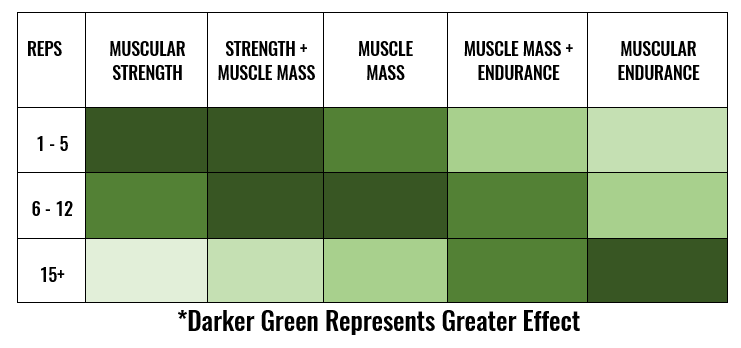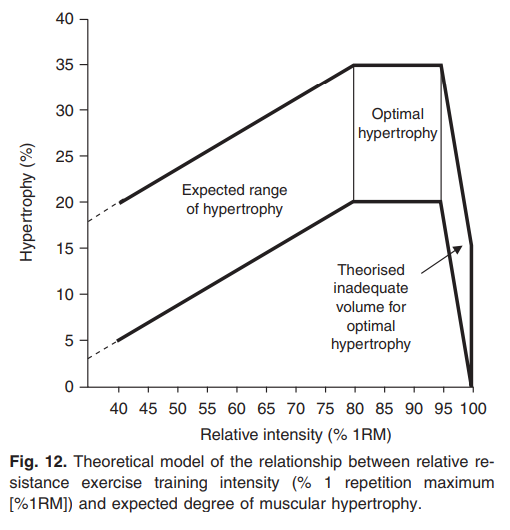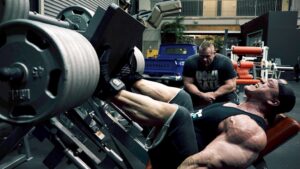Many people get confused about how many reps/sets, they should perform in order to stimulate muscle growth. The most recent study suggests that any person should feel comfortable doing between 8-12 reps for 4 sets maximum But as human beings, we have different DNA’s and it defines the type of training, workouts, diets, and supplements we should stick to on. Always do research on what works best for you.
The optimal number of reps per set to achieve maximum muscle growth is a fiercely debated and disputed subject amongst the bodybuilding community.
If you go to any popular bodybuilding forum and ask, “What’s the best rep range for muscle growth?” you’ll have a variety of different numbers thrown at you, and you’ll end up even more confused than before you asked.
The amount of contradicting opinions on this question is staggering.
Everyone seems to have their own “expert” opinion on the “perfect” rep range for muscle growth.
The biased muscled meathead at the local gym, occupied with moving as much weight as possible in an unwitting move to feed his ego will always tell you to “go heavy”.
And the reserved internet researcher might regurgitate some “facts” he was told on a bodybuilding forum.
Neither of these sources are very helpful.

So, back to the question – what rep range should you really be training in to maximize muscle growth?
It’s a simple question, with a somewhat complex answer, that I hope to make understandable in this post.
Plus, I’m going to provide some solid scientific studies on this subject.
The truth is, muscle growth can be achieved by training within more than one rep range, there’s no “magic” or “perfect” single rep for building muscle.
There is much more overlap than people think, as increases in muscle mass are seen across of wide spectrum of repetition ranges.
With that said, there is a narrow rep range to work within most of the time to optimize when training for gains in muscle size.
Rep ranges are often categorized into 3 main “loading zones” and each are quite well accepted and validated by studies to produce the following primary outcomes.
Low (heavyweight):
1 – 5 reps are within the “Strength Range”, used primarily to increase muscular and neurological strength. If you’re looking to get strong as possible, then this is your zone.
Medium (moderate weight):
6 – 12 reps are within the “Hypertrophy Range”, used primarily to build muscle mass. If you’re looking for an edge to build as much muscle as possible, then most of your training would be performed within this rep zone.
High (lightweight):
15+ reps are within the “Endurance Range”, used primarily to increase muscular endurance. If you’re out to train your muscles so that they perform better over an extended period – think boxer or a marathon runner – then this is where you’d do most of your training.
Of course, there is plenty of overlap (a lot, actually) in result outcomes across these ranges, as you can see from this visual illustration.

For example, you can build a lot of strength from training in the mid “hypertrophy range”, and you can build a lot of muscle from training in the low “strength range”. It’s just that you’ll get more of one outcome over the other, depending on which range you train within.
And the rep range you choose will depend on what training goal you’re pursuing – more muscle, more strength, or more stamina.
I’ve extensively researched this subject and from my experience and study can confirm that you should be training within the 6 – 12 rep (8- 10 being most optimal) range most of the time if you want to maximize gains in muscle growth.
So why does training in this rep range produce the greatest gains in size?
Rep Range for Hypertrophy
Let’s get one thing straight – feeling the “burn” from very high rep training does not cause growth.
And lifting outrageously heavyweights that induce trembling arms and bloodshot eyes is not the catalyst, either.
Growth stimuli from resistance exercise is caused by a combination of mechanical tension and fatigue-induced metabolic stress, and to some degree, muscle damage.
Optimize mechanical tension and metabolic stress and you’ll maximize muscle hypertrophy.
Warning: things might get a little “sciency”, but bear with me, as all will become clear if you stick to the end.
Mechanical Tension
Lifting weights creates a level of tension across your muscle fibers.
This mechanical tension regulates the size of your muscles through a process called “mechanotransduction” where the mechanical forces cause an intracellular anabolic response.
The magnitude and the duration of the load lifted creates the stimuli that brings about hypertrophic adaptations.
In other words, the type of load – or, how heavy the weight is – is the primary driving force behind the building of muscle mass.
When your muscles adapt and grow from sets and reps of resistance weight training, they aren’t responding to numbers, they’re responding to tension.
If you choose to lift a lot of heavy weights, the load is high, and the reps will be low.
If you choose to lift a very lightweight, the load is low, and the reps will be high.
Now, some of you might be thinking, heavier weight lifted means more tension, and that more tension means more muscle growth.
But that’s not the case, because very heavy loads don’t allow for much time under tension, or for the accumulation of metabolic stress.
Heavyweights mean less metabolic stress, and light weights mean less mechanical tension.
Moderately heavy weight provides a good balance between the two, meaning your trained muscle will get an optimal combination of growth stimuli.
You’re not just picking 5 reps, or 8 reps, or 12 reps, you’re picking the right “load intensity” or “weight” for your goal, and it’s the number of reps you select that determines the load.
To help you understand how load and reps impact growth, you need to understand something called your one-rep max or 1RM.
But before we get into that, let’s talk about another contributor to hypertrophy – metabolic stress.
Metabolic Stress
Training with moderate heavyweights within the 8 – 12 rep range is where metabolic stress “kicks-in”, which is the exercise-induced accumulation of metabolites within the muscle.
Minimal metabolic stress is seen in training routines involving very heavy loads.
Metabolic stress also causes muscle cell swelling and increased muscle fiber recruitment – factors that contribute to the growth promotion of the whole muscle.
Cell swelling is a phenomenon that increases intracellular hydration and has been shown to increase protein synthesis and reduce muscle degradation, which is really the key drivers behind augmenting muscle tissue.
Muscle Fibers and Rep Ranges
Skeletal muscles are made up of a mixture of two main types of muscle fibers.
Type 1, known as “slow-twitch” fibers, respond better to light weights / high reps. They don’t fatigue easily and are not very powerful.
Type 2, known as “fast-twitch” fibers, respond better to heavy weights / low reps. They fatigue easily and are the most powerful.
Your muscles are made up of around 50% type 1 and 50% type 2 fibers, give or take. The lower body tends to have slightly more type 1 fibers compared to the upper body.
It would make sense to assume that lighter, high rep sets would favor the growth of type 1 fibers, and that heavier, low rep sets would favor the growth of type 2 fibers. There is some scientific evidence out there to support this theory.
However, training with moderately heavy loads within the 8 – 12 rep range taken close to failure will recruit ALL muscle fibers, fairly equality – Type 1, Type 2a, and Type 2b – so there’s no need for fiber-specific training.
The aforementioned 8 – 12 rep range gives the best combination of muscle fiber recruitment, metabolic stress, mechanical tension, and time under tension for the goal of muscular hypertrophy.
Understanding Your One Rep Max to Build Muscle
To build muscle, you need to maximize muscle protein synthesis and inhibit protein breakdown.
Maximum protein synthesis has been shown to occur between 70-85% of your one-rep max (1RM).
1RM – One repetition maximum, is the maximum amount of weight a person is able to lift for a single repetition.
Don’t know your 1RM? – No problem.
The chart that follows will help you find a good estimate, but before you get to that – here’s an interesting study I want to share with you.
A study in 2009 conducted by Kumar et al. (Journal of Applied Physiology) measured the fluctuations in muscle protein synthesis after weight training.
They found that the anabolic response (muscle building) increased by:
30% after training with weights that were 20% of 1RM
40% after training with weights that were 40% of 1RM
100% after training with weights that were 60% of 1RM
130% after training with weights that were 75% of 1RM
100% after training with weights that were 90% of 1RM
As we can see from this information, the peak of muscle growth occurs when training with a weight that is around 75% of our 1RM.
The reason that the growth response is lower at 90% of 1RM is because the weight is just too heavy.
This weight causes the nervous system to fatigue first, not the muscle fibers.
This means that the muscles are not receiving enough time under tension to trigger the adaptive growth response or any metabolic stress.
So how many reps is 75% of your 1 RM?
Take a look at the chart below to see how 1RM percentages relate to repetitions:
100% of 1RM = 1 rep
95% of 1RM = 2 reps
93% of 1RM = 3 reps
90% of 1RM = 4 reps
87% of 1RM = 5 reps
85% of 1RM = 6 reps
83% of 1RM = 7 reps
80% of 1RM = 8 reps
77% of 1RM = 9 reps
75% of 1RM = 10 reps
67% of 1RM = 12 reps
65% of 1RM = 15 reps
As you can see, 75% of your one-rep max works out at around 10 reps. That means, if you reach failure on the 10th rep of bench pressing 80kg, then 80kg is 75% of your 1 rep max.
If you reach failure at the 8th rep, then whatever weight you’re using for that exercise would be 80% of your 1 rep max.
So, training anywhere between 8 – 12 reps to concentric failure is the optimum rep range for muscle growth.
Studies show that training within this moderate range with a weight you can handle with good form is best for building mass.
Let’s take a look at a couple more studies.
Study 1
| Age-related differences in the dose-response relationship of muscle protein synthesis to resistance exercise in young and old men | The Journal of Physiology | 10.1113/jphysiol.2008.164483 (source)
In this study, the researchers found that the growth response also peaked with weights that were around 75% of 1RM.
Again, if you look at the 1RM percentage chart: 75% of 1RM = 10 reps
Researcher comments:
“At 1 h post-exercise at 60-90% 1 RM, p70s6K phosphorylation predicted the rate of MPS at 1-2 h post-exercise in the young but not in the old. The results suggest that in the post-absorptive state: (i) MPS (Muscle Protein Synthesis) is dose dependant on intensity rising to a plateau at 60-90% 1 RM“
“Rather than the hyperbolic relationship we postulated, they show a sigmoidal dose-response relationship of myofibrillar protein synthesis to exercise intensity, with little increase from 20 to 40% 1 RM, then a bigger rise at 60% of 1 RM, with no significant further increase up to 90% 1 RM.“
In laymen’s terms, it means that muscle growth was maximized with weights around 10 reps to failure. You can see from the graph below how there’s a gradual increase in growth stimuli, which tapers off after 75% of the 1RM.

What’s also interesting to note from this study is the wide range where muscle growth peaks.
Study 2
| The Role of Resistance Exercise Intensity on Muscle Fibre Adaptations Andrew C. Fry Human Performance Laboratories, The University of Memphis, Memphis, Tennessee, USA (source)
This was a study that looked at data from many studies to see how weight selection affects muscle growth.
Researcher comments:
“Although many training variables contribute to the performance, cellular and molecular adaptations to resistance exercise, relative intensity (% 1 repetition maximum [%1RM]) appears to be an important factor.”
“Examination suggests that there may be a threshold for optimal growth responses. Once relative intensity reaches 80% 1RM, it appears that maximal growth is attained. Within the scope of the data available for this review, maximal growth occurs with loads between 80-95% 1RM.“
Their findings concluded that growth stimulation peaks around 80% 1RM, very similar to the first study and that there is in fact a threshold where the growth response is optimized.
80% of 1RM = 8 reps

Take-Home Points from These Studies
As you can see from these studies, there’s no single best number of reps to build muscle, just like there’s no single best exercise, or single best protein source, for building muscle, either.
Muscle growth can be achieved using a variety of rep ranges.
However, to maximize size, the scientific literature provides us with an optimal range to work within, most of the time.
It is easy to get caught up in the “more is better” mindset, which often guides beginners into lifting too much weight or doing too many reps, but doing so will quickly lead you to the point of diminishing returns.
If the weight is too light, you will be able to perform lots of repetitions, but the tension on the muscle will be minimal and not enough to stimulate significant growth.
If the weight is too heavy, you will cause the nervous system to fatigue first, not the muscles. This means that the muscles are not receiving enough stimulation and time under tension to trigger growth optimally.
Lifting too heavy a weight can also compromise form, leading to a limited range of motion, distribution of tension to supporting muscle groups, and increased risk of snapping your sh*t.
And, workouts with very heavy weights will reduce volume. The onset of fatigue from moving heavy loads will diminish workout intensity and effort, resulting in not only less reps and sets per workout but a reduction in quality repetitions.
My recommendation is to shoot for failure (the point at which you don’t have enough strength left to perform another rep) around 8 reps to maximize muscle growth. This will ensure you are working with weights that are around 75 – 80% of your 1RM, the scientifically proven “sweet spot” where optimal muscle growth is achieved.
Working in this rep range provides the best combination of mixed muscle fiber recruitment, mechanical tension, metabolic stress, and muscle damage.
Remember, it’s the muscular TENSION produced in this range that’s important. The degree and duration of tension is responsible for stimulating muscle growth.
The studies above have provided us with a clear way to optimize this tension, to squeeze the most growth from every set.
That’s not to say you should only ever use this rep range. It’s good to change things up sometimes. You may want to go heavy with 5 reps or lighten up and work in the 12+ rep range from time to time.
All of the rep ranges mentioned will cause muscle growth to occur, just in different ways and to various degrees.
Recommendations Rep Range for Mass
The bottom line is that most of your training should be done within 8 – 10 reps as this has been found to be the best rep range for size.
Around 85% of your training should be within this moderate-intensity loading zone.
The other 15% can be made up of any other rep range.
For example, switch to heavy, low rep work for a week or two, a couple of times a year to build strength.
Or switch to some lighter, high rep work for a couple of weeks to improve muscular endurance and enjoy a better “pump”.
There may be some benefit to utilizing rep ranges across the entire spectrum, such as increasing strength, or endurance, but for building muscle, most of your training should be within the 8 – 10 “hypertrophy zone”.
This will optimize your sets for growth by providing optimal levels of metabolic stress and mechanical tension, while also allowing you to get the best quality work in, as this load allows you to exercise muscle groups with the greatest range of motion while maintaining good form throughout each set.

For more news and updates, follow IFBNewsfeed.Org on Facebook, Twitter, and Instagram.






